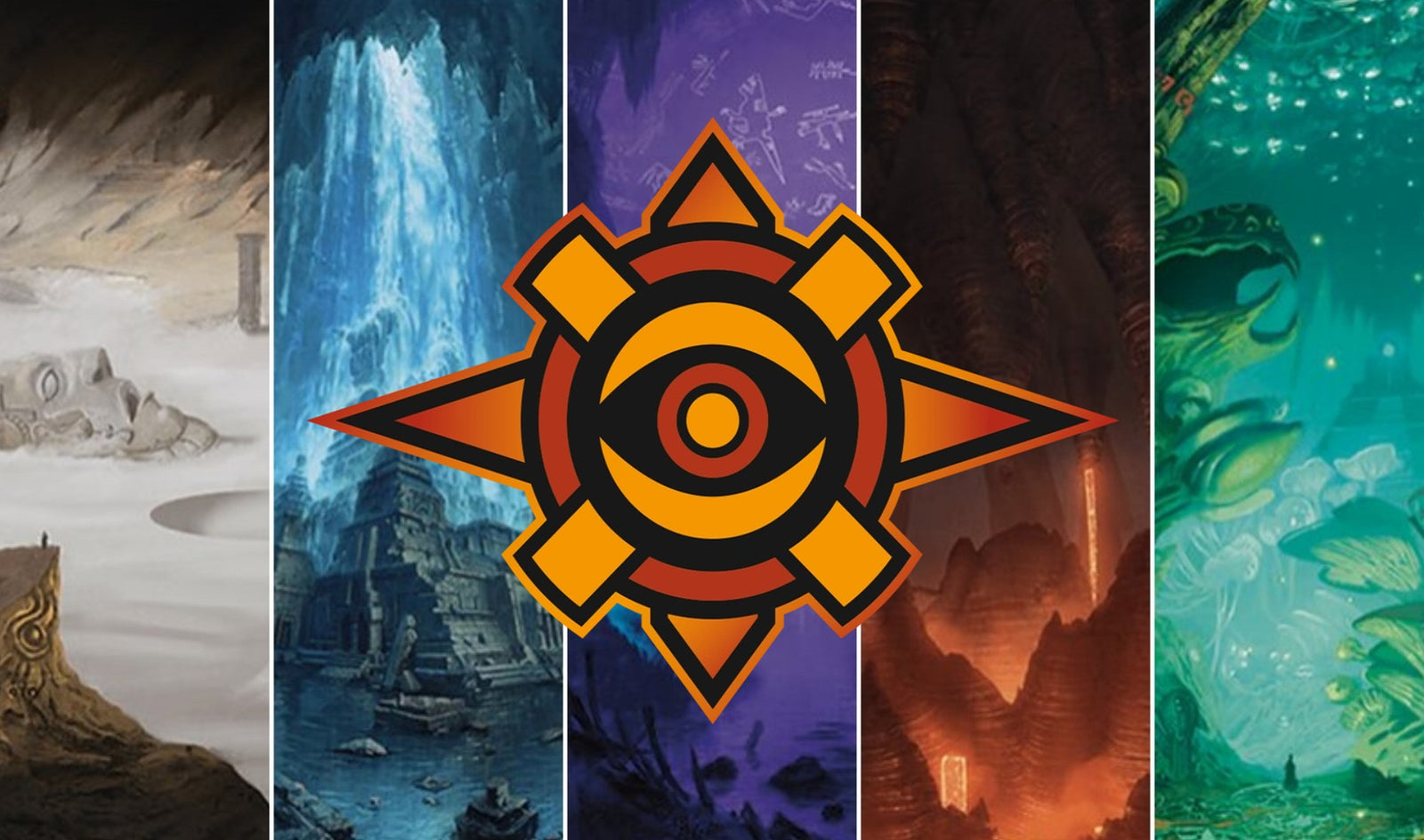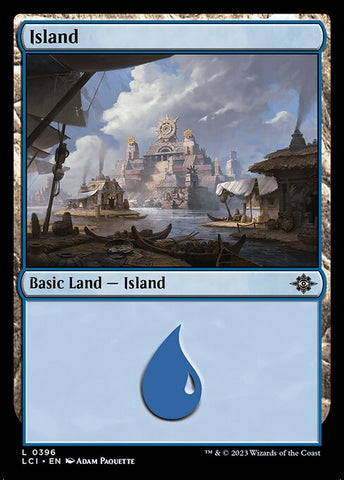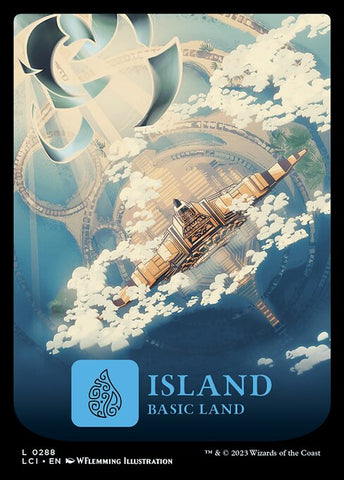Menu

0
Your Cart is Empty

Your Cart is Empty

January 19, 2024 9 min read 0 Comments
It’s easy to overlook Magic: the Gathering’s Basic Lands. Most players have more than enough for them to be mechanically meaningful, and they lack any kind of financial value for the most part, leaving them as gap fillers in card galleries more often than not.
This is a great shame, however, as Basic Lands serve as some of the most effective windows into Magic’s intricately detailed world that we have access to. Each offers a slice of worldbuilding in its purest form: no characters, no events, just an unfiltered look at the world of a set, often with small details that hint at the time period or context in subtle ways.
The Lost Caverns of Ixalan continues this proud tradition, presenting a fresh batch of 15 Basics for us to pore over. As befits a set themed around ancient secrets and buried mysteries, there are plenty of little details waiting to be unearthed in the artwork for each. Quite literally, in the case of the five Basics explicitly set within the Lost Caverns themselves.
In this article, we’ll delve deep into the two variants on each of the Basic lands in the set, before taking a special look at the Full-Art Core Lands, a bold new style created just for this expansion. Grab your ropes, picks, and spelunking helmets: this is going to be an expedition for the ages.

The Plains of The Lost Caverns of Ixalan will serve as the base camp for our deeper explorations, immediately establishing a pattern that will echo through into the rest of the Basics in the set. For each Basic type, there are two art variants: one set within a cave, and one set on Ixalan’s surface. This makes a lot of thematic sense in a set so concerned with caves, and also provides unique opportunities for Magic’s artists to explore what a ‘cave’, a traditionally black or red structure, would look like in each of the other three colors.
The white cave land, for example, is one of the most evocative in the set. Carlos Palma Cruchaga portrays the last gasp of a once-powerful civilization, fading away into nothing as its buildings and idols are slowly consumed in an inevitable trickle of sand. Said sand forms a sort of desert on the cave floor, cleverly evoking the sprawling plateaus that are more often the norm for Plains artwork. It’s a powerful image, bringing to mind Shelley’s Ozymandias, with the look on the huge statue’s face mirroring the quiet tragedy of the situation as a whole. Above the ruins, on a ledge in the bottom-left of the piece, a tiny figure looks upon the works of this ancient civilization and despairs.

The other Plains in the set comes to us from Adam Paquette, and gives a glimpse into the agricultural practices of Ixalan. In one snapshot, we see two different stages of crop growth: the still-growing stalks on the right, and the finished crops on the left, cut and bundled into bell-shaped bales. Through the middle, a cracked path runs up to a series of houses in the background, giving an idea of the technological era the Plane is in at present. Along the side of the road, stone walls hold a thin river of water, likely some kind of irrigation system for the fields. These are all lovely details that ground the Plane in human reality, but pan your eyes deeper into the piece and you’ll find hints of grander designs. A temple sits on a rock in the background, beneath a sky filled with clouds, periodically pierced by shafts of sunlight. These elements serve as reminders that Ixalan is governed by Magical logic too, especially important given that the set introduced the Plane’s Gods.

Dipping into the Islands of the set reinforces the themes established by the Plains. The cave Island, lovingly rendered by Nestor Ossandon Leal, shows an underground temple slowly eroding away under a waterfall spilling through the cave roof. The temple is clearly in disrepair, shown through the tumbled columns around it, but many of the rocks in the cave appear to be naturally occurring, serving as reminders that the temple was built using the same stone in the past. The symmetry of the piece, which glows bright in the center and grows dark towards the corners, lends the temple a feeling of divine importance, undercut by the viewer’s knowledge that it will one day be worn away to nothing.

The other Island, also from Adam Paquette (All five of the non-cave Basics are his, in fact), shows us how the residents of Ixalan have adapted to life on the water. We see several buildings set upon rafts, a layer of hay on top for extra protection. These appear to serve a range of purposes, with the one on the left looking like a blacksmith’s forge, while those on the right seem to form a kind of market. In the foreground and throughout gondolas are visible, revealing the way in which residents travel between these floating amenities in daily life. All of this lies in the shadow of an active temple, which sits proudly in the middle background of the piece. Throughout human history, it hasn’t been uncommon for communities to spring up around places of worship, and this is clearly the case here, with the residents adapting to the unique location of the water God’s temple by building their community on the river itself.

Given black’s affinity for the deep, dark corners of the Multiverse, a black cave land seems like a no-brainer for the artist responsible. Logan Feliciano chose to take this one in an interesting direction, however, with clever use of lighting that lends the piece a surprisingly gentle, welcoming air. The cave portrayed here is the final resting place of a number of Ixalan’s dinosaurs, with scattered ribs and full skeletons strewn across the watery floor. The first of Feliciano’s clever lighting tricks is the addition of luminescent blue mushrooms, which can be seen growing on the ‘shores’ of the cave, as well as in the mouth of the skeleton in the left foreground. This creates a haunting atmosphere, particularly when paired with the glowing glyphs on the cave wall beyond. These are reminiscent of real-world Aztec art, and clearly depict the dinosaurs that now lie dead in the cave, continuing the theme of ‘greatness lost’ seen on the other cave lands we’ve examined so far.

Adam Paquette’s Swamp, though set above the surface, feels thematically similar to Feliciano’s. He shows a section of Ixalan swampland, including a small temple, that has fallen into decay and disrepair. A pair of palm trees rot above the stagnant water below, beyond which lies the crumbling ruins of two sun-topped temples. Their varying heights imply that both are slowly sinking into the mire, with the one in the foreground closer to its ultimate fate than its background counterpart. The piece as a whole has an air of hopelessness about it thanks to the thick grays and the heavy background mist, feeling like a corner of the world completely devoid of life or light. This makes a great contrast with Paquette’s other Basics for the set, and fleshes out the world of Ixalan by confirming that there are some regions where humanity has failed to find a foothold.

In another break with Lost Caverns’ established Basic land traditions, Muhammad Firdaus’ cave Mountain doesn’t show the remains of a once-great subterranean empire, but rather takes a simpler route, showing the innards of a volcanic cave network instead. While this tells us less about the culture of Ixalan and its people than its peers, it reveals more about the Plane’s physical structure, and how the caves we’ve been exploring elsewhere in the set were originally formed. Firdaus makes great use of a strong contrast between light and dark, playing bright orange lava flows off against dark stalagmites and stalactites. The lava flows down, from various sources, into a river on the cave floor, which casts a subtle orange glow that illuminates the strata of every inch of cavern, letting you count their layers like those of an old oak tree. It’s a simple piece, but still highly evocative, feeding into the idea of Ixalan as a primordial, ancient Plane.

For his Mountain, Adam Paquette goes back to the pattern established with his Plains and Island, highlighting the way that the people of Ixalan have adapted the mountainous areas of the Plane to their needs, essentially ‘taming’ them. Cable cars have been strung between different points on the mountainside here, linking directly to a pair of Ixalan’s famous sun-crested temples. This is a neat bit of primitive industrialization, providing a means of accessing these remote temples for those not physically capable of reaching them via the path snaking up from the bottom right of the scene. It makes a great deal of sense from a worldbuilding perspective, and is another great example of the period of advancement we find Ixalan in in this set, and how the old ways haven’t been abandoned in its wake, but rather embraced.

We round things off with the Forests of the set. Carlos Palma Cruchaga returns from his stunning cave Plains, discussed above, to deliver an equally beautiful cave Forest. This one breaks from the rest of the cycle by showing an area bursting with life, though echoes of the previously-established theme of ancient civilizations being consumed by nature can still be heard in its verdant depths. This piece shows huge plants, mushrooms, vines, and broad-leaved fronds, overgrowing a series of pillars with curious red markings. In the background, a classic Ixalan temple can be seen, lurking in the shadows among the stalactites. There’s an overwhelming feeling of energy in this one, like the civilization that used to live here and worship at the temple hasn’t so much vanished, but instead been replaced by new life in the form of towering plants. The lone figure in the center of the frame serves two purposes: to give a sense of scale, reinforcing just how colossal the flora in the piece is, and to add some intrigue. Maybe the temple here isn’t totally abandoned. Maybe adherents still make the perilous trek through the underground forest to worship there to this day. Cruchaga leaves the door open for these possibilities and more with this single, splendid touch.

The final Adam Paquette land from the set is this tasty-looking Forest. Spotlighting a dense section of rainforest, through which a river courses like blood through a central artery, Paquette does a number of interesting things with this one. Firstly and most obviously, he shows the sun-crested temples, which we’ve seen throughout the lands for this set, linked by bolts of purple lightning. This likely implies some sort of ritual in progress, but it could also be an ancient system of communication, similar to Tolkien’s beacons of Minas Tirith. Either way, it’s a striking visual, feeling decidedly high-tech and out of place in the world of Ixalan, and all the more effective for it. Outside of the temples, the piece is fully-realized, with rainforest and river mingling perfectly, mists rising on the far bank in a masterful touch. It’s a nice way of conveying the close relationship between green and blue in this set, owing to the Merfolk archetype that uses both colors, and an excellent study in realistic natural environments to boot.
Full-Art Core Lands


Now that we’ve covered all of the standard Basic lands in The Lost Caverns of Ixalan, we’re going to shift gears a little and talk about the Showcase lands for the set: the Full-Art Core Lands. These don’t fit neatly into the above discussion because of their more stylized nature, which makes it difficult to extract reliable worldbuilding information from them, but they’re still worth covering as striking pieces of artwork in their own right.

Looking at these lands, and the font and style they use, it’s immediately clear that they were intended to evoke vintage travel posters, the aesthetic of which, in turn, informed promotional material for many classic adventure films. All five make the world of Ixalan look dangerous and alluring, whether it’s a winged dinosaur soaring above a geometric city in Olga Tereshenko’s Plains, or an aerial view of a stunning temple in WFlemming Illustration’s Island. There’s a running motif of characters with staves, reminiscent of walking sticks, overlooking each piece, hammering home the idea of the pilgrimage, or grand adventure, that awaits you on this Plane. There are also hints of more esoteric mysteries, like the huge stone cutouts in the sides of BEMOCS’ Mountain, or the strange bird motif, reinforced by the feather patterns and ‘beak’ jutting out of a ruined sun-crest, on Elektrodeko’s Swamp.

Finally, Matteo Bassini’s Forest is pure adventure postcard goodness, with bright colors, an inviting window onto the world, and enough landmarks, both major and minor, to tempt you over the threshold. All five are excellent, and a great thematic fit for Ixalan, a Plane which seems to have supplanted Zendikar as Magic’s go-to for traditional swashbuckling adventure.

And there you have it. We’ve scoured every inch of every piece of art for every Basic Land in The Lost Caverns of Ixalan. We’ve gleaned many interesting insights, but such is the depth and complexity of Magic art that there are undoubtedly some details we’ve missed, some stones we’ve left unturned that reveal even more about the Plane than we have here.
Feel free to check the Lands out for yourself, and report any interesting discoveries in the comments below! It’s been an honor having you along with us on this remarkable journey, and we hope to see you again soon for more deep dives into Magic’s anything-but Basic Lands.
Sign up to get the latest on sales, new releases and more …